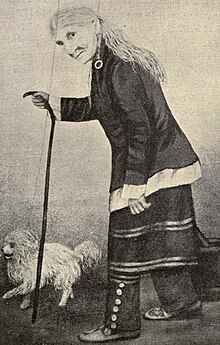Mary Jemison | |
|---|---|
 Illustration, from an 1892 account of missionary activity in upstate New York | |
| Born | Mary Jemison 1743 At sea on the Atlantic Ocean |
| Died | September 19, 1833 (aged 89–90) |
| Other names | Dehgewänis |
| Known for | adopted Seneca and for her memoir |
Mary Jemison (Deh-he-wä-nis) (1743 – September 19, 1833) was a Scots-Irish colonial frontierswoman in Pennsylvania and New York, who became known as the "White Woman of the Genesee." As a young girl, she was captured and adopted into a Seneca family, assimilating to their culture, marrying two Native American men in succession, and having children with them. In 1824, she published a memoir of her life, a form of captivity narrative.
During the French and Indian War, in spring 1755, Jemison at age 12 was captured with most of her family in a Shawnee raid in what is now Adams County, Pennsylvania.[1] The others of her family were killed. She and an unrelated young boy were adopted by Seneca families. She became fully assimilated, marrying a Delaware (Lenape), and, after his death, a Seneca man. She chose to remain a Seneca rather than return to American colonial culture.[1]
Jemison told her story late in life to an American minister, who wrote it for her. He published it as Narrative of the Life of Mrs. Mary Jemison (1824). It was reprinted in the late 20th century. In 1874 her remains were reinterred near a historic Seneca council house on a private estate, in what is now Letchworth State Park.
- ^ a b Seaver, James E. (2015-01-26). A Narrative of the Life of Mrs. Mary Jemison. University of Oklahoma Press. ISBN 978-0-8061-4891-5.